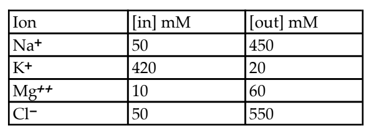Though you are an attentive parent, you lost track of your inquisitive toddler for a few minutes, just long enough for him to wander into the garage and open a package of insecticide that you use to control insects in your garden. You have no idea if any of the poison has been ingested, inhaled, or absorbed through his skin. You take the package away from your child and read under the "caution"
section that it is an anticholinesterase. Given that this poison was made for insects, not humans, should you be worried? Explain your answer. What would happen to the child if he has indeed been affected? Explain which type of synapses could be affected. Propose an antidote (it's OK if you don't remember a specific compound, just describe what type of effect may reverse the effects of the insecticide).
You and your fellow deep-sea scientists have discovered a new form of marine invertebrate, and are anxious to determine the similarities and differences to animals already characterized. Chemical analysis reveals the following concentrations of permeable cations:

Nernst equation: Eion = 61/z × log [ion]out/[ion]in
Insects have acetycholine receptors that are similar enough to ours so that yes, you should be worried. Anticholinesterases block the degradation of acetylcholine, thereby prolonging its effects in both muscarinic and nicotinic synapses. If the dose is high enough, spastic paralysis could result, in which muscles contract uncontrollably. If this happens with the respiratory muscles, the victim may die of suffocation. Autonomic effects
would also be expected, including sweating and nausea. A chemical such as atropine, which blocks muscarinic receptors, will alleviate some of the symptoms. Oximes (not mentioned in text) block nicotinic receptors and can be administered to counteract nicotinic effects of the poison.
You might also like to view...
What area of the brain integrates visual and olfactory stimuli to give you a complete "picture" of what you are eating?
What will be an ideal response?What will be an ideal response?
What is the functional unit of compact bone?
A) osteon B) lacunae C) lamellae D) canaliculi E) trabeculae
Which of the following is most likely to happen to a group of students who relax by drinking a pitcher of their favorite beverage?
A. an increase in urine volume B. an increase in urine osmolality C. an increase in ADH production D. increased aldosterone secretion E. a decrease in urine volume
Oligodendrocytes serve the same purpose in the CNS that satellite cells do in the PNS
Indicate whether the statement is true or false